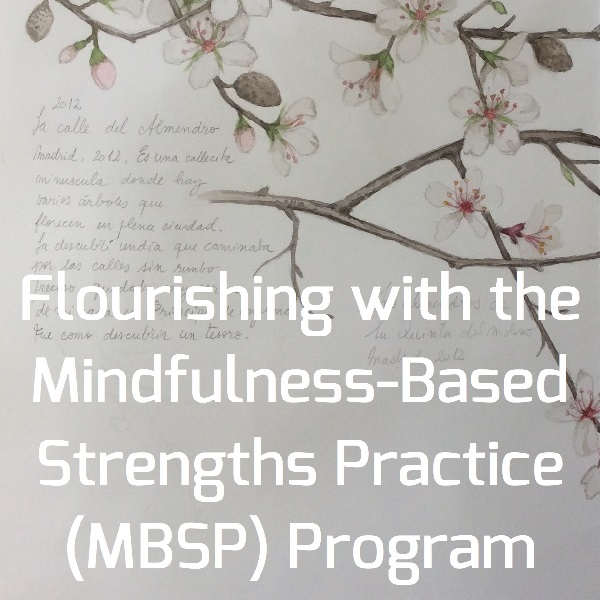Recent research at the University of Zurich shows the correlation between character strengths, mindfulness and flourishing. We are launching a series of online and in-person Mindfulness-Based Strengths Practice (MBSP) workshops to fully experience flourishing in life. Subscribe to our newsletter.
Correlation Between Character Strengths, Mindfulness and Flourishing
Recent research at the University of Zurich shows the correlation between character strengths and flourishing (Wagner et al., 2019). Research results show that all character strengths are positively related to flourishing, measured against all PERMA dimensions of Seligman (2011), though there are differences in the size of the relationships. Accomplishment, for example, is strongly associated with perspective, persistence, and zest, whereas for positive relationships, strengths such as teamwork, love, and kindness are the best predictors. These findings provide further support for the notion that character strengths contributes to well-being and they could guide the development of strengths-based interventions tailored to individual needs. This is precisely what Ryan M. Niemiec, Education Director of the VIA Institute on Character, has done recently authoring a compilation of character strengths interventions (Niemiec, 2018).
Other recent study, also conducted at the University of Zurich, shows that two mindfulness programs (i.e., Mindfulness-Based Stress Reduction (MBSR), Kabat-Zinn, 2013 & Mindfulness-Based Strengths Practice (MBSP), Niemiec, 2014) are effective for increasing well-being and increasing job satisfaction. MBSR also specifically reducing perceived stress, and MBSP also increasing task performance (Pang & Ruch, 2019).
Flourishing Is Not Opposite to Languishing
For many people positivity is the opposite to negativity, and physical and mental health means not having physical and mental illness. This is a common wrong view with unfortunate and limiting personal and social consequences. Taking care of physical and mental illness in face to life problems is certainly needed (e.g., stress, anxiety, fear and depression in face to the pace of technological change, financial uncertainty, information overload, complexity in life, consumerism and global events affecting us beyond our control). But it is important to know that decreasing languishing does not increase flourishing.
In line with the PERMA construct proposed by Seligman in 2011, flourishing means experiencing a pleasant life (i.e., positive emotions, positive relationships, and accomplishment), an engaged life and a meaningful life. Let’s focus on the first component of the PERMA flourishing construct: positive emotions. « Positive affectivity (PA) and negative affectivity (NA) are nearly independent of each other. » (Naragon & Watson, 2009). This is not new, already in 1969, « Norman Bradburn showed that pleasant and unpleasant affect are somewhat independent and have different correlates—they are not simply opposites of one another. Thus, the two affects must be studied separately to gain a complete picture of individuals’ well-being. This finding had important implications for the field of subjective well-being: It showed that clinical psychology’s attempts to eliminate negative states would not necessarily foster positive states. The elimination of pain may not result in a corresponding increase in pleasure; ridding the world of sadness and anxiety will not necessarily make it a happy place. » (Diener et al., 2002, p. 64).
Flourishing Requires Specific Flourishing Programs
Flourishing and languishing operate in two completely different axes and are decorrelated (Keyes, 2002). As Keyes pointed out in 2007, this indicates that social and personal investments in reducing languishing do not substitute the personal and social investments needed for promoting flourishing. Not seeing this clearly, and not acting on it accordingly, prevents from enjoying the benefits of flourishing individually and in society. Indeed, Keyes (2007) found that less than 20% of the USA population is flourishing. In the EU, the highest national level of flourishing was measured in Denmark at around 33%. In UK it was just under 20% (Huppert & So, 2009). I don’t believe this situation has changed today.
The decorrelation of languishing and flourishing has a consequence for the positioning and prescription of mindfulness programs. This is, each program has a specific purpose, for example, MBSR reduces stress, Mindfulness-Based Cognitive Therapy for Depression (MBCT) (Segal et al., 2013) decreases depression relapse probability, and MBSP increases flourishing. None of these programs can be seen, nor prescribed, as a generic alternative for any other.
Flourishing Requires Resources and Conditions
« To flourish means to live within an optimal range of human functioning, one that connotes goodness, generativity, growth, and resilience. » (Fredrickson & Losada, 2005, p. 678). Flourishing requires the development of personal traits (i.e., the VIA character strengths and virtues) that are commonly agreed across different cultures (Seligman et al., 2005) and the right personal and social conditions of autonomy, competence and relatedness (Ryan & Deci, 2000).
According to the Self-Determination Theory (SDT) (Ryan & Deci, 2000), self-regulation is one of the pillars of human functioning and growth, but only when accompany with other supporting strengths, like for example: open-mindedness, curiosity and perspective, and more importantly, the intention to transform and flourish with the natural processes of intrinsic self-motivation, as well as the energy, perseverance, inherent enjoyment, and satisfaction that goes with it. Not a surprise we have just mentioned most of the ingredients, if not all, of the mindfulness construct. This may explain why mindfulness is instrumental for flourishing. The question relative to the components of the mindfulness construct, and how they relate with the self-as-process in SDT and with the flourishing construct will be developed in a coming post.
In our January 2020 post we presented flourishing as a deliberate cultivation of character strengths traits, and we also explained how character strengths guided mindfulness meditations can be used for gardening the mind and flourish. It is worth though to mention here the positive relationship between mindfulness and positive affect and the flourishing outcomes of mindfulness and positive emotions combined, described as an upward spiral process by Garland, Gaylord and Fredrickson (2011).
Gardening the Unconscious Mind for Flourishing
The combined flourishing effects of mindfulness and positive emotions operates in many different layers: physiological, conscious and unconscious (Fredrickson, 2013). It may be reassuring to believe that our rational mind is in control, but the fact is that our unconscious mind is (Wright, 2017). The benefits of gardening the unconscious mind with a flourishing intention (transformation at the base) has been known and practiced by Zen Masters from centuries (Nhat Hanh, 2006, 2009). The most famous mindfulness programs focus on diminishing stress and cognitive diseases (languishing). We believe the potential of mindfulness programs specifically designed for flourishing deserve much more attention. This is the reason why we have introduced MBSP in Switzerland in 2019. Today we are happy to announce the next series of online and in-person MBSP workshops starting end of May, where we will fully experience flourishing with mindfulness and character strengths in life.
Jaume Gallifa, MBA, ACC is the Managing Director of Gallifa & Partner LLC, a professional services company specialized in transformational change and flourishing. He can be reach at jaume.gallifa@gallifa.ch or via LinkedIn.
[accordion align=”” numbers=”false” first_one_open=”true”]
[pane title=”Flourishing with Mindfulness-Based Strengths Practice (MBSP). An 8-week in-person program starting on Friday, January 15, 2021 in Basel, Switzerland”]
MBSP brings together the latest science of mindfulness and character strengths into an active learning experience to help people flourish by getting in conscious contact with their inner strengths.
The brochure attached contains detailed information about the 8-week in-person MBSP program that will take place in Basel, Switzerland, starting on Friday January 15, 2021 at 18h at Zentrum für Achtsamkeit Basel/Center for Mindfulness Basel.
Thematic and info workshop sessions to learn more and experience the integration of mindfulness and character strengths for flourishing are offered regularly. Details and inscriptions at the Lausanne event page or the Basel event page.
[/pane]
[/accordion]
References
– Bradburn, Norman M. (1969). The Structure of Psychological Well-Being.
– Diener, Ed et al., (2002). Subjective Well-Being: The Science of Happiness and Life Satisfaction. In Snyder, C. R. &, Lopez, Shane J. Ed. (2002). Handbook of Positive Psychology.
– Fredrickson, Barbara L. &, Losada, Marcial F. (2005). Positive Affect and the Complex Dynamics of Human Flourishing. American Psychologist, 60(7), 678–686.
– Fredrickson, Barbara L. (2013). Positive Emotions Broaden and Build. In Devine, Patricia &, Plant, Ashby ed. (2013). Advances in Experimental Social Psychology, 47, 1-53.
– Garland, Eric L.; Gaylord, Susan A. &, Fredrickson, Barbara L. (2011). Positive Reappraisal Mediates the Stress-Reductive Effects of Mindfulness: An Upward Spiral Process.Mindfulness.
– Huppert, Felicia A & So, Timothy T. C. (2009). What percentage of people in Europe are flourishing and what characterises them? Well-being Institute, University of Cambridge, Briefing Document for OECD/ISQOLS meeting “Measuring subjective well-being: an opportunity for NSO’s”, Florence, July 23-24.
– Kabat-Zinn, Jon (2013). Full Catastrophe Living: How to cope with stress, pain and illness using mindfulness meditation. Revised Edition.
– Keyes, Corey L. M. (2002). The Mental Health Continuum: From Languishing to Flourishing in Life. Journal of Health and Social Research, 43, 207-222.
– Keyes, Corey L. M. (2007). Promoting and Protecting Mental Health as Flourishing. American Psychologist 62(2), 95-98.
– Naragon, Kristin; Watson, David (2009). Positive Affectivity. In Lopez, Shane J. ed. (2009). The Encyclopedia of Positive Psychology, 707-711).
– Nhat Hanh, Thich (2006). Understanding Our Mind: Fifty Verses on Buddhist Psychology.
– Nhat Hanh, Thich (2009). The Blooming of a Lotus: Guided Meditation for Achieving the Miracle of Mindfulness.
– Niemiec, Ryan M. (2014). Mindfulness and Character Strengths: A Practical Guide to Flourishing.
– Niemiec, Ryan M. (2018). Character Strengths Interventions: A Field Guide for Practitioners.
– Pang, Dandan &, Ruch, Willibald (2019). Fusing Character Strengths and Mindfulness Interventions: Benefits for Job Satisfaction and Performance. Journal of Occupational Health Psychology, 24(1), 150-162.
– Ryan, Richard M. &, Deci, Edward L. (2000). Self-Determination Theory and the Facilitation of Intrinsic Motivation, Social Development, and Well-Being. American Psychologist, 55(1), 68-78.
– Segal, Zindel, Williams, Mark &, Teasdale, John (2013). Mindfulness-Based Cognitive Therapy for Depression, Second Edition: A New Approach to Preventing Relapse.
– Seligman et al. (2005). Positive Psychology Progress – Empirical Validations of Interventions. American Psychologist, 60(5), 410-421.
– Seligman, Martin (2011). Flourish: A Visionary New Understanding of Happiness and Well-being.
– Wagner, Lisa; Gander, Fabian; Proyer, René T; Ruch, Willibald (2019). Character Strengths and PERMA: Investigating the Relationships of Character Strengths with a Multidimensional Framework of Well-Being. Applied Research in Quality of Life
– Wright, Robert (2017). Why Buddhism Is True. The Science and Philosophy of Meditation and Enlightenment.



